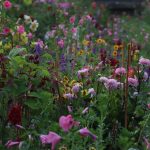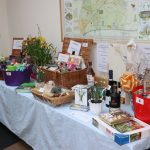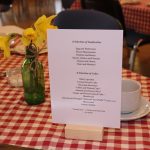2026 Monthly Meetings
‘Chelsea Secrets’
Pip Bensley
Wednesday 14th January 2026, 2.30 pm
Lavant Memorial Hall
Tea/coffee available after the talk
This is a special look to see what goes on behind the scenes at The Royal Horticultural Society’s Chelsea Flower Show.
Pip has been part of 25 Hillier Nurseries’ Gold Medal winning gardens, helped build Show Gardens, Trade Stands, RHS “Special Features” and competed in the Floral Art competition winning three gold medals herself. She is now a senior RHS judge chairing a judging panel at Chelsea. She is the gardening expert on BBC Radio Solent and also a NAFAS National Judge and Teacher. On top of all this, she runs a floristry business in Southampton!
SPECIAL EVENT- FEBRUARY 2026
‘Barnsdale after Geoff
(1996-present day)’
Nick Hamilton
Wednesday 11th February 2026, 2.30pm Followed by Afternoon Tea
To be held at Boxgrove Village Hall
Talk and Tea, is our successful February Meeting format and once again, we return to Boxgrove Village Hall for this popular event. This year we welcome Nick Hamilton, who’s father Geoff will be fondly remembered as the long-serving presenter of Gardeners’ World from 1979-1996.
Nick Hamilton developed his passion for gardening, aged 9, when his father purchased a derelict garden centre in Kettering. He worked with his dad at weekends and during school holidays. He trained at Writtle College and took a National Diploma course in commercial horticulture. His sandwich year placement sent him to Darby Nursery Stock in Norfolk, one of the largest wholesale container nurseries in the country and they asked him to return for full time employment once his course had ended.
Nick gained valuable experience there and at other nurseries until his father purchased a piece of land, adjacent to Barnsdale, in 1989. This land formed the nursery and ultimately part of Barnsdale Gardens and Nick worked closely with his father in the family business.
Nick took over the running of Barnsdale Gardens when Geoff died and has developed it into the inspirational garden that it is today, which is not only a credit to a great man but also to Nick’s passion, foresight and hard work. These inspirational gardens are still run using organic and peat-free principles and are visited annually by about 30,000 people, who range from keen gardeners to non-gardeners with all learning a bit, as well as just enjoying a trip around a beautiful garden. You will find Nick at Barnsdale on most days, occupying the “hands on” role he so enjoys.
Over the years Nick has also managed to fit in appearances on Gardeners’ World, writing books, being a regular contributor to gardening magazines, contributing to the various Talks Stages at major flower shows, tutoring most of the courses being run at Barnsdale whilst still getting out and about. Nick has displayed in the Great Pavilion at The Chelsea Flower Show and in the floral marquee at the Gardeners’ World Live Show. He is also the President of The Cottage Garden Society, a position he took up in 2007.
This is a ticketed event.
Tickets are now available to members (your 2026 subs must be paid!).
Tickets are £10 for members.
Should any tickets be available for non-members, these will be £15. You may apply for a ticket for one guest and we will let you know after the monthly meeting on 14th January if your application has been successful.
Tickets will be allocated in order of application. Please do not make payment for guest tickets until you are notified of availability. If you would like to pre-book a ticket and/or add a guest to the waiting list, please click here:
This year’s raffle proceeds will be split equally between two charities:
The Sussex Snowdrop Trust, a local charity, in support of their work providing ‘Nursing Care at Home’ for local children who have a life-threatening or terminal illness.
St Wilfrid’s Hospice is an independent charity which supports local people in our community who are living with a life-limiting or terminal illness.
2025 Previous Monthly Meetings
See below for the reports
‘Gales, Greenhouses & Global Warming’
Ian Currie
Wednesday 10th December, 2025
Lavant Memorial Hall at 7.30pm
Ian is a full-time weatherman, broadcaster, author, columnist, speaker and editor of Weather eye magazine. He has written and co-written several country weather books.
He is a Fellow of the Royal Meteorological Society and he can be heard regularly on BBC Radio Surrey and Sussex with forecasts for gardeners and growers including vineyards in our area.
The subject matter of this talk is relevant after we have had a record-breaking summer and a dry spring and last year the warmest February in our national record and the previous year the warmest June and September.
Annual General Meeting 2025
Wednesday 12th November at Lavant Memorial Hall.
Report to follow
New format for 2025:
7.00pm Members meet for refreshments, wine and nibbles, in the Green Room
7.30pm Members AGM
8.00pm Open to ALL
Liz Sawday from Apuldram Roses
‘PUTTING YOUR ROSES TO BED FOR THE WINTER’
Report to follow
‘Shrubs; Discover the Perfect Plant for every Place in your Garden’
Andy McIndoe
Wednesday 15th October, 2025
Preceded by the Autumn Flower Competition
We were very pleased to welcome Andy McIndoe back to Lavant Horticultural Society, not only to judge the Autumn Flower Competition but also to give us an excellent talk about every possible aspect of Shrubs.
He covered soil types, garden sizes, positions, habit, foliage, flowers, fragrance, colour and pruning.
All were illustrated with fabulous slides, showing these impressive plants along with both simple and complicated plant names and lots of humour. What a very enlightening and enjoyable evening for the large audience.
His book of the same name ‘Shrubs: discover the perfect plant for every place in your garden’ is a very useful addition to all gardeners’ bookshelves.
Andy McIndoe
‘Succession Planting’
Steve Edney
Wednesday 10th September, 2025
It was good to welcome back Steve Edney from The No Name Nursery in Sandwich, Kent where he has been working his 3-acre site for just over 5 years. The No Name Nursery
The nursery is named after No Name Street in the same town, as opposed to Steve not knowing what else to call It!
Steve was a very knowledgeable and entertaining speaker who has been a dedicated horticulturalist since leaving school.
When planning your garden, he recommends a visit to the RHS Trial Gardens, where you can judge characteristics of plants that might be suitable for your garden.
Many of his comments were well illustrated by a video of the nursery’s 100 x 6 metre long border showing structure, colour and succession right through to mid-winter.
Altogether an evening full of ideas when considering future planting. Members also enjoyed buying some of the excellent plants Steve had brought along.
‘Succession Planting’ was the subject of his talk which was based on 10 basic rules:
- Know what you’re growing – Start with pencil and paper, list the plants already in the garden, noting when they flower and for how long.
- Use bulbs for early colour.
- Spend time making notes and planning a timetable – it won’t happen overnight.
- Water the roots of plants just before they flower, they’ll then flower for longer.
- Foliage and form are as important as flowers – take some black and white photographs, these make it easier for the eye to judge suitability, so that colour is not a distraction.
- Use long-flowering plants to anchor your border around.
- Deadhead – like your life depends on it, aided by a G’n’T if it helps.
- Don’t neglect late-flowerers and seedheads.
- Make use of perennials that are dormant in summer.
- Embrace annuals and exotic plants.
‘From Cutting to Garden Centre
How Plants are Grown for your Garden’
Graham Spencer
Wednesday 9th July, 2025
Graham Spencer runs Plants for Europe which offers plant breeders guidance through the whole development process.
‘I didn’t know that’ was the phrase Graham wanted to hear from his audience and it was certainly the response to this entertaining and very informative talk.
From the delicate transfer of pollen by breeders to the appearance on trolleys outside your supermarket or in the garden centre is a fascinating life journey for our plants.
We learned that the best breeders had the biggest skips of rejected plants – only those of the best quality being kept. Sometimes 20 from a trial of 2,000.
The cuttings, after a thorough evaluation, comparisons and testing for pests and diseases, are sent to sunnier climates for rooting. At all stages, testing for pests and diseases is rigorous.
One of the most impressive aspects of plant production was the vast spaces used and the numbers of plants grown.
Upon return to Europe, many to Amsterdam, the cuttings go to a rooting station. A video showed a robot transferring each small plant into a cell of growing medium with efficiency and speed. Millions of plants are grown in huge glasshouses but they are watered by hand as humans are still best at checking the health of plants!
However, robots win in the speed and accuracy of the spacing of containers.
Graham continued the story with the transport to retail outlets where trays are recycled and trolleys marked with identification data so that they could be returned correctly. He also told us about marketing, international shows and so much more.
We will certainly view our much-travelled plants with more respect in future.
‘Super Seasonal Displays’
Mark Saunders
Wednesday 11th June, 2025
Click to enlarge
‘SUMMER SOCIAL’
Wednesday 11th June 2025
Members gathered early before the talk for a glass of prosecco, a few nibbles, and to meet and mingle with other members. The turn out was good on this sunny evening, despite a warning that the A286 was going to be closed for all with a homeward journey using that road. Forward planning by our Programme secretary rescued the evening. Negotiating with the contractors for an agreed convoy to come through at 9pm, meant that everyone was able to stay for Mark’s engaging talk which followed.
‘Dahlias’
Richard Ramsey
Wednesday 9th April 2025
Richard’s talk covered Classification, Propagation and Maintenance.
From fairly insignificant flowers originating in Mexico, Central and South America Dahlias were initially developed in Spain. Further development by Dr Dahl in 19th century Germany produced Fancy and Pom Pom varieties. At one time eating the tubers for medicinal purposes was advised but it did not catch on!
We amateur gardeners were guided through the year from reviving tubers in February, taking cuttings, potting on, planting out and tying to supports.
Propagation by cutting ensures plants that are true to type, as seeds can cause genetic variations and inferior flowers.
As florists prefer long stems, Richard emphasised the importance of disbudding to leave long, strong stems and good flowers.
Detailed information and colourful slides made an entertaining evening and generated enthusiasm to grow these varied, increasingly popular plants.
Several members bought tubers on the night, so let’s hope they grow well and put in an appearance at the Annual Flower Show this year.
‘Hardy Annuals’
Pamela Holt
Wednesday 12th March 2025
Pamela Holt, a keen rock climber and photographer, has used these skills in her travels in Europe, Russia and Africa. She collected plants for the Royal Botanic Garden at Kew when visiting Peru and Bolivia.
On Wednesday 12th March, her talk entitled ‘Hardy Annuals, covered a comprehensive description of the areas in the world where they originate. As these are either hot and dry or cold and dry they are the easiest of the three kinds of annual to grow. They can be sown directly outdoors into finely raked, relatively poor, soil in the flowering position.
Ideal for the economical gardener because the seeds are easy to collect and store for sowing the following spring.
After guiding us through the origin of the plant names, many from Greek myths, she showed slides of many examples of both common and exotic flowers.
‘Plant Hunter and Gardener with Passion’
Tom Hart Dyke
12th February 2025
Tom Hart Dyke gave this talk to more than 100 members and their guests, at our February meeting held at Boxgrove Village Hall.
Tom gave a vivid, enthusiastic description of his plant hunting adventures around the world, and this was followed by an excellent afternoon tea provided by the hard-working club members who make up our catering team.
The Hart Dyke family has lived at Lullingstone since 1316 and they still live in one of the towers of the Tudor Gatehouse of 1496. Once stretching north as far as London the area today is a modest 126 acres, but still full of interest.
Tom spoke of his Granny who inspired his love of plants by giving him a packet of seeds and a trowel when he was just three years old. It is never too early (or too late) to discover the joy of growing common or exotic plants. His other Grandmother maintained a silk worm farm supplying beautiful material for many special Royal wedding and Christening garments.
In the summer of 2020, days of heat and drought, the temperatures of 40OC, caused the lawns to dry and turn brown but when rains finally came the grass returned to green and giant puff balls, some a metre across, sprang up.
Having received grants to travel for plant collection he visited every continent except Antarctica This part of his talk was accompanied by fascinating, colourful slides of orchids, Protea, Strelitzia, Baobab trees and many more.
However, the most hair-raising section was his capture, at gun point, in Columbia in 2000. Several months in captivity followed, during which time he and a friend were kept on the move as his captures criss-crossed the jungle. Towards the end as they feared for their lives, Tom planned a World Garden, which thankfully he has since been able to create at Lullingstone.
Sited within the walled garden he has planted vegetation from each continent he has visited, laid out in the shape and global position of each. This World Garden with polytunnels, glasshouses and more, including The National Collection of Eucalyptus, accredited in 2009 with around 100 different provenances, is all well worth a visit. Lullingstone Castle
The talk was followed by a fabulous afternoon tea and an extensive raffle in aid of The Sussex Snowdrop Trust. A charity that does amazing work giving home nursing care for local children (from new-born to 19-year-olds) with life threatening or terminal illnesses.The Sussex Snowdrop Trust
Click to enlarge
‘Parham Gardens, moving forwards’
Andrew Humphris
Wednesday 15th January 2025
Members and guests enjoyed an afternoon of colourful gardens when Andrew Humphris, Head Gardener at Parham House, gave this talk. Inspired by his father, who had been an influential figure in the world of horticulture, he began by giving a resume of his extensive career which amounted to a virtual tour of some of the most interesting gardens in England. Starting with his first job at The Savill Garden he moved to the National Trust Garden at The Courts, one similar to Hidcote in the layout of ‘rooms’. After a period at Biddulph Grange, in 2003 he became Head Gardener at Wollerton Old Hall in Shropshire. All this was illustrated by some wonderful slides, including that of a large herbaceous border at the latter garden which was 60’ long and 16’ wide. Following a time at West Lodge Estate in Dorset he took his present post at Parham in 2021, where in addition to the large garden, there are 850 acres of parkland with a heritage breed of dark fleeced deer. In this part of his talk Andrew described the task which he faced at Parham to eradicate the very invasive bindweed among the plants. Started in 2020, it has been a long job, which has necessitated digging out the contents of the beds, cleaning the plants, leaving each bed fallow for a while before replanting. Clearly it had to be done in stages because nobody wants to visit a garden empty of plants with just bare soil to look at! As the team near the end of this project now, Andrew’s vast experience in both renovation and the creation of gardens and landscape will stand him in good stead as he takes Parham Gardens forward. The Gardens are open from 20th April and are well worth a visit. Parham House.
2024 Monthly Meetings
Scroll down for reports
‘Soil Health linked to Gut Health’
Dr Jane Gleeson
Wednesday 11th December 2024
This startling comment illustrated the importance of knowing how to create and maintain this amazing substance. It takes 1000 years to create 1 centimetre of soil by erosion of bedrock and decomposition of organic matter.
At this monthly meeting Dr Jane Gleeson gave an illustrated talk about ‘Soil Health linked to Gut Health’ and it was obvious she felt strongly about her subject. After spending ten years in the field of mental health she changed the course of her life to become a horticulturalist. She mentioned Albert Howard who, in the first half of the 21st century, travelled to India to teach the farmers about artificial fertilizers and pesticides, and was surprised to find they were able to grow food in a sustainable way without these chemicals. He had learnt a valuable lesson.
Dr Gleeson took us through the soil food web from soil health, plant health and animal health to human health. It was a wonderful biology lesson including explaining why we should not dig unless really necessary to avoid damaging the delicate biosystems surrounding growing roots. We learnt so much, including that nematode worms are the most abundant life form on the planet.
Visit https://www.soilfoodweb.com/ as there is so much to learn, and although this website is for farmers it applies equally to gardeners.
Our guts need a balanced diet of fruit, vegetables, protein and fibre. One of the many slides illustrated the essential bacteria in action in our colon.
Finally, we were encouraged to check the ingredients of packaged food in shops. ‘If you don’t know what it is – don’t buy it’
Altogether a fascinating talk containing lots of ‘food for thought’.
‘Great Companions:
Ornamental Grasses and
Excellent Perennials’
Marina Christopher
Wednesday 9th October 2024
preceded by Autumn Flower Competition
Marina runs Phoenix Perennial Plants, a nursery near Alton suppling unusual plants to some of the top designers for their gardens at Chelsea Flower Show that have won ‘Best in Show on several occasions.
After the excellent talk on Late Summer Flowers that Marina gave at our September 2022 meeting in 2022, we were not disappointed – an enjoyable evening with lots of useful information. Again, Marina brought lots of the plants to show us, rather than just relying on images.
Grasses make up about 20% of the planet’s earthmass and, being wind pollenated, are not reliant of pollinators. Marina not only took us through a wide range of grasses and their possible uses in the garden, but also covered herbaceous perennials and other plants that mix well with them.
‘Propagation’
Ray Broughton
Wednesday 11th September 2024
Having trained at RHS Wisley in the mid-1970s, Ray was Head of Horticulture at Sparsholt College for 12 years. In 2000, he was awarded a Fellowship of the Chartered Institute of Horticulture in recognition of his services to horticultural education. He then taught staff and students at RHS Wisley where he was chief examiner.
This knowledge and experience shone through in a talk full of useful information on many aspects of propagation, all presented in an enjoyable and accessible way.
In addition, Ray gave a large number of useful tips; here are just some of them:
Clean up secateurs by leaving the blades in tomato ketchup for a few days. It is the vinegar that does the work, but if you just used vinegar it would evaporate or run off, whereas the ketchup keeps it in contact with the metal.
You can do the same thing with hedge trimmer blades, using a squeezy bottle of ketchup.
In the spring seedlings and cuttings can get very leggy. This is not due to low light levels, but the lack of carbon dioxide that is needed for photosynthesis. To provide a source of CO2, put some fairly fresh manure in a two litre plastic pot, cover with cling film and make holes in the film. Use from February through to the end of April.
Hardwood cuttings, for example of cornus or buddeja, should be taken in November.
One way to make them easier to look after is to use a “Dutch roll”.
Take a length of plastic sheet cut from an old compost bag, black side up, and cover it with a one inch layer of compost. Place the cuttings spaced out along it, roll it up and tie it up.
Keep it over winter, lying horizontally somewhere dark and cool, like a shed or garage.
Open it up in April, when roots should have started to form, and pot up individually.
When filling a seed tray always make sure the compost in the corners is also firmed down, otherwise moisture will migrate there, leaving the centre dry.
When sowing dark coloured seed, mix with a little cornflour so that the seed will show up white against the compost.
To remove any surplus seed from the seed tray, rub a plastic pen to create static so the seed will jump up to the pen.
Don’t cover seed too much, but even seed that needs light to germinate should still be covered with very thin layer of compost or vermiculite.
When dividing dahlia tubers make sure each division has a stem; without a stem it will not grow.
Hose down hedges mid-December to mid-January to remove female aphids sheltering there before they lay their eggs.
Beware euonymus and nasturtium, as they excrete sucrose which attracts aphids.
‘How to be a 21st Century Gardener’
Timothy Walker
Wednesday 12th June 2024
Timothy was the director of Oxford Botanic Garden for 26 years and is now lecturer in Plant Sciences at Somerville College Oxford.
His talk focussed on how gardeners can cope with many of the challenges they are facing from environmental changes whilst reducing their use of natural resources.
He pointed out that in spite of gloomy predictions by nurserymen they have been able to become peat free.
He succeeded in making this not only interesting and informative, but also thoroughly enjoyable.
The talk was structured in the following ten chapters, all spiced with humour:
- Look after your soil;
- Choose plants that like your soil;
- Grow more native plants;
- Grow more fruit and vegetables;
- Reduce watering;
- Reduce pesticide use to the minimum;
- Adapt to climate change;
- Look after endangered species;
- Gardening for nature;
- New gardeners.
Click to read more details Show less
This is most important thing. It is said that you can improve soil, but not change it. Timothy had found in his own garden that it can be changed, but this was only feasible for a small area, needing to replace the soil going down three spade depths.
Prioritise making your own compost – do not let the compost heap dry out, otherwise the bacteria et al. that break it down will not be able to function. The compost heap also needs nitrogen, not to enrich the final compost, but to promote these things that break down the heap into compost.
such as Guelder Rose Viburnum opulus.
Lots of natives make very good hedging plants, e.g. hazel, sloe (blackthorn), hawthorn.
Other natives worth growing: ox-eyed daisies, ragged robin, bugle, foxgloves, yellow mullein, honesty.
Avoid exotics that could pose a threat if they break out into the wild.
by concentrating on plants that do not need constant watering.
If watering is required (such as growing vegetables) he recommended the use of porous soaker hoses in the soil, which get the moisture where is is requited, rather than traditional watering, where a lot is wasted on the foliage.
Use predators to control greenhouse pests instead and encourage toads, hedgehogs and thrushes to help control slugs and snails. Use copper tape or copper containers to protect hostas.
Also choose resistant plants/varieties –
e.g. mildew resistant Aster varieties, such as ‘Blue Danube’ and ‘Little Carlow’.
“Wimbledon chop” – similar to Chelsea chop, but carried out at the start of July, to produce more flowering heads and shorter stems on asters.
Mediterranean plants can be useful to cope with rising temperatures and drier summers, but should not be used in rich soils, as they thrive on poorer stony ground, as in the Delos Garden at Sissinghurst.
Timothy presented the example of critically endangered Euphorbia stygiana, native to the Azores, but hardy down to minus 15oC.
He had set up a project to propagate this species at Oxford, with the work carried out by young members of his team, which was very successful.
Encourage the development of young gardeners to looks after gardens in the future.
In the examples of projects at Oxford University Botanic Gardens, the work of young team members was highlighted.
‘The Arts and Crafts Movement and its Gardens’
Stephen Harmer 2024
Wednesday 10th April
Stephen has a master’s degree in Garden History and teaches at RHS Wisley. His favourite subject is the history of the Arts and Crafts garden, and he has incorporated some of its principles in his gardening at Tonbridge School, where he is Head Gardener.
The gardens inspired by the Arts & Crafts Movement were supposed to be the closest to the traditional English garden; however, this was something that never really existed. Influenced by Italian renaissance and Persian gardens, they rejected the formality of the typical Victorian garden and its reliance on blocks of bedding plants. Following Ruskin’s lead that nature should be used as the inspiration, the Arts & Crafts movement rejected shoddy Victorian mass production; it was generally anti-industrial, focussing instead on hand made craftsmanship and preferring simplicity to the over-elaborate decoration of the day.. Its leading light was William Morris and much of his influence can be seen in his favourite residence, Kelmscott Manor.
What is outside the garden is just as important as what is inside it. Carefully placed “windows” should give views out into the surrounding countryside.
William Robinson, the influential gardener and writer, with his popular and influential books “The Wild Garden” (1870) and “The English Flower Garden” (1883), described how this style of garden should look. The garden should look absolutely natural. Exotic plants could be used, but on condition that they could survive unprotected in an English garden throughout the year. Planting should be so dense that by mid-May no soil should be visible. This can be seen as the start of the modern mixed border.
The garden must surround the house, with flower gardens to be overlooked by family rooms, looking south. The garden must have:
- wild flower meadow (any flowers that would naturalise could be used);
- a sports lawn;
- different levels and terracing;
- strong hedges;
- a formal forecourt;
- symmetry, with a vista;
- use local materials;
- timbers, especially oak;
- old fashioned flowers and vegetables;
- old gnarled fruit trees;
- a nuttery.
Robinson put his principles into effect by purchasing Gravetye Manor, near East Grinstead, and transforming the garden.
Notable exponents of the Arts & Crafts style were Gertrude Jekyll and Sir Edwin Lutyens. Prime examples of their own designs: Munstead Wood, Gertrude Jekyll’s own house and garden; Upton Grey Manor, designed by Jekyll and Lutyens; this garden subsequently fell into complete neglect, but has been faithfully restored by current owner, Rosamund Wallinger.
Arts and Crafts elements lived on even after the real Arts and Crafts period had finished, e.g. Sissinghurst (and Vita Sackville-West and Howard Nicholson’s previous experimental garden, Long Barn) and Great Dixter.
Steven explained that 1916 marked the end of the Arts and Crafts gardening movement; the huge number of First World War casualties, exemplified by the Battle of the Somme that year, meant that the manpower needed for the upkeep of such gardens was no longer available.
‘Designing Small Gardens’
Annie Guilfoyle
Wednesday 13th March 2024
The Spring Flower Competition was held before the meeting.
Award-winning garden designer Annie Guilfoyle combines a successful consultancy, Creative Landscapes, with lecturing and writing on the subject.
She has a long association with West Dean College, where she organises all the garden courses and teaches some of them; she also teaches garden design at Great Dixter.
Internationally, Annie lectures and runs garden design courses in several Europe locations and in the USA.
She imparted this knowledge and experience in an excellent presentation, full of useful information delivered in an appealing way.
The following notes do not do the talk justice, only capturing some of the points Annie made.
She considered the small garden as perhaps the most challenging for a designer, compared to a large area and unlimited budget. The features of a small garden can be used in many settings; indeed, many large gardens are a compilation of smaller ones: e.g. Sissinghurst and, to some extent, Great Dixter.
One theme that Annie mentioned repeatedly in her talk was offsetting main features, such as patios, steps, decking, at an angle of 45o to the perimeter of the garden. This gives the garden an impression of being larger, as the eye is drawn to the longest, diagonal, length. Also, it gives larger spaces for planting, compared to a narrow border surrounding, say, a patio that is not offset.
It has the additional benefit that the eye is not taken directly to the other end of the garden, making it appear more complex and larger.
She showed several gardens that she had designed as examples, including:
- East Molesey, Surrey
- Kew This garden measures just 4m x 4m. Evergreens. Decking set at 45o.
- Arundel – again hard landscaping set at 45o, giving deeper spaces for planting.
- Hove This garden shows an example of another theme that Annie mentioned several times: reuse what is already there – in this case an underused swimming pool repurposed as a pond, with the decking giving it a curved edge to dissimulate its origins.
Reusing what is already there saves the cost of a great deal of material and of bringing it in or taking it out, as well as being ecologically more sustainable.
This garden also has a gate with the start of gravel path leading into the border and, by implication, to another part of the garden, whereas, in fact, it doesn’t lead anywhere. The gate is left slightly open – always more inviting.
Water features are important in any garden, no matter how small. Their sound adds another, relaxing, dimension that can distract from noise coming from outside.They also bring in wildlife.
In small garden, you can remove lower foliage from a large garden shrub, so that it looks like a small tree, in proportion to the garden.
Use climbing plants to add another dimension and to extend the flowering period when growing through earlier flowering shrubs.
Korean lilac Syringa meyeri is exceptionally fragrant and its size makes it particularly well suited to small gardens.
Use more specialised nurseries for access to a wider choice of plants, mentioning in particular:
Colour :
In a small garden go for muted colours, as they will make it feel larger.
Using bright colours will make the space appear even smaller.
Shade plants:
Annie mentioned, amongst others Gillenia and ferns, which she considers much underrated.
Use dark foliage plants to set off lighter colours.
Bulbs – excellent for small gardens, as they will make their appearance through other planting and once flowered will then disappear again.
Showing just how small gardening can get, Annie introduced something with many potential sites in our area: pot hole gardening
‘Revive Your Garden’
Nick Bailey
Wednesday 14th February 2024
Boxgrove Village Hall
This special LHS event welcomed Gardeners’ World presenter Nick Bailey to speak on a subject that many of us could benefit from.
The audience of 100 was captivated by Nick’s masterly presentation of a great deal of very useful information leavened with anecdotes and humour.
The talk and the ensuing questions were followed by a delicious afternoon tea.
The Sussex Snowdrop Trust Chairman and Co-Founder, Diana Levantine, gave a short description of the trust and its wonderful work as a unique charity providing ‘Nursing Care at Home’ for local children who have a life-threatening or terminal illness.
The proceeds of the bumper raffle were donated to The Sussex Snowdrop Trust. Many thanks to all those who donated prizes.
Nick’s eloquent and well illustrated talk went through the aspects to be considered when planning to revamp a garden, starting from what you have to work with: the plots, its size and aspect, the soil and other possible limitations, existing planting.
Then to the essential decisions: what you want from your garden: –
‘Form follows function’ (Corbusier).
What of the existing planting can be rejuvenated.
How to use pruning to help achieve this.
How can it be enhanced by additional planting.
How to get rid of really troublesome weeds.
And very much more.
Click this Points & Plants link to see more details of what Nick mentioned in his talk.
Nick’s excellent talk, rounded off by a lovely afternoon tea with home made cake, made for a very enjoyable and instructive afternoon.
‘Clematis through the Seasons’
Everett Leeds
Wednesday 10th January 2024
Everett has had an interest in clematis for over forty years. Member of the International Clematis Society and founder member of the British Clematis Society (Chairman four times), he has co-written two books on clematis.
His knowledge and enthusiasm were evident in the talk that was very well received by a large gathering of members.
History
The native Clematis vitalba (Old Man’s Beard) was the only clematis known in England until the reign of Elizabeth I, when Clematis viticella was introduced from southern Europe.
Other European clematis were then introduced: C. recta, herbaceous, not a climber, with small white flowers, and C. integrifolia, again herbaceous, not a climber, from the alpine region.
It was not until the 19th century that plant hunters introduced species from China, C. patens and C. lanuginosa that brought larger flowers and new colours.
In the late 1850s Jackman’s nursery, Woking, bred C. jackmanii, which had a much larger flower size than any previous clematis.
A hybridisation race then ensued.
Ca. 1900 clematis wilt appeared.
C. texensis was introduced just before 1900 from Texas, bringing red tulip-like flowers.
Propagation from cuttings Read more Show less
The basics of taking the cutting can be seen here, although Everett made the following points:
Before putting the cuttings into the pot, put them in a plastic bag with some systemic fungicide, to allow the leaves to take up the fungicide and help protect the cutting from fungal attack.
He puts the cuttings up to their necks around the edge of a pot filled with pure perlite.
This then goes into a propagator, or failing that, is covered with a clear plastic bags secured with a rubber band around the pot.
He sprays the cuttings with weak systemic fungicide once a week.
After 5-8 weeks the root system should have developed – this can be checked by feeling the resistance when pulling lightly on the cutting.
The cutting can now be potted on, in John Innes No 3 with a handful of grit, into a pot which is only just large enough for the roots; if the pot is too large, the roots will tend to rot.
Keep damp and pot on when the roots fill the pot.
It is best to keep the new plant in a pot until it can be planted out the following spring.
When training up trees that are still alive, plant clematis away from the tree, to the north, and train it up against the trunk with a cane.
Feeding – Everett recommended that clematis be fed with rose fertiliser.
Including those from all the following groups:
Early season species:
Early large-flowered clematis:
Can be affected by clematis wilt which can affect all the plant or just parts of it. Cut off all affected parts and dispose of in bin.
It is recommended to plant deep, so that the part of the plant in the soil may escape wilt.
If the plant does not recover it can be replaced with another clematis in the same place – there is not the same problem as there is with replacing roses.
With their large blooms, they are susceptible to damage by wind and rain, so they are best planted in a sheltered location. Also, they do not like too much direct sunlight, so plant in east-, west- or even north-facing locations, but not in south-facing.
There are about 4,000 cultivars.
Late flowering clematis:
Prune hard to about 1 foot in February.
Herbaceous Group:
Bushy, non-climbing, grow to a height of 0.75 – 1.25 m.
At end of season cut down to 20 cm ready for winter.
Herbaceous clematis do not like too high temperatures, so when planting in containers, insulate the inside of the container, e.g. with bubblewrap; must be watered at least once a week.
















